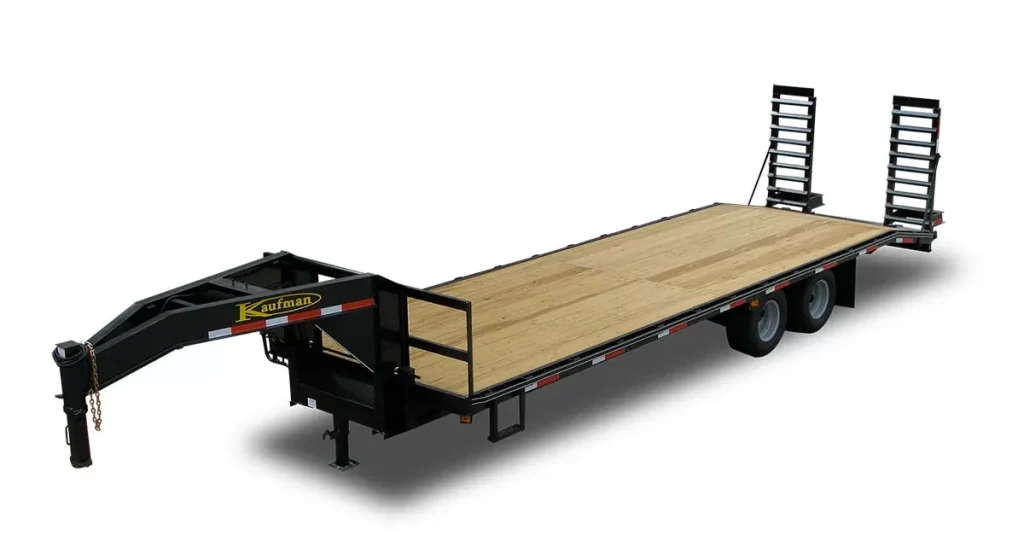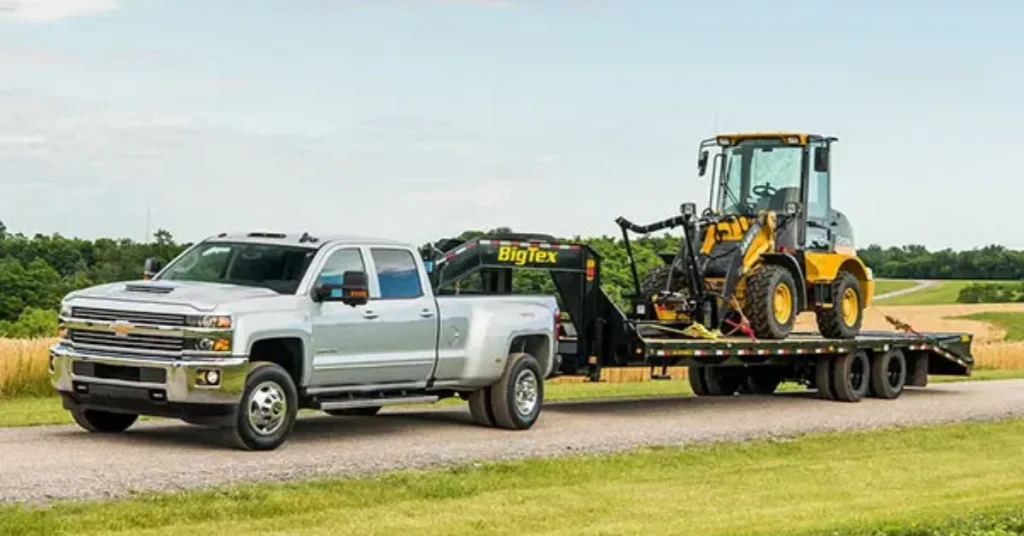A standard gooseneck trailer typically measures about 8 feet wide. This width is consistent with legal road limits.
Exploring the dimensions of a gooseneck trailer is essential before making a purchase or planning to transport goods.
The typical width of 8 feet ensures that the trailer adheres to legal requirements for highway travel without needing special permits. This width enables efficient use of space while maintaining maneuverability and stability on the road.
It’s important for haulers to know these dimensions as they directly impact the payload and the type of goods that can be transported.
Trailers exceeding this width may require additional considerations such as route planning and permits.
Understanding the size of a gooseneck trailer can significantly affect operational logistics, ensuring safe and compliant transit.

Gooseneck Trailers Unveiled
Gooseneck trailers are known for their stability and unique coupling method. Designed to handle heavy loads, they offer a distinct advantage over traditional trailers.
This post dives into the world of gooseneck trailers, unfolding their dimensions and exploring their versatility in hauling tasks.
Identifying A Gooseneck Trailer
A gooseneck trailer is easily spotted by its curved coupling arm. This arm attaches to a ball hitch in the bed of a pickup truck. Difference and recognition come from the arm’s shape, resembling a goose’s neck.
Typically, these trailers span 8 to 8.5 feet in width. The National Highway Traffic Safety Administration (NHTSA) mandates this for the trailer to be road legal without special permits.
Benefits And Common Uses
- Tight turns: Enhanced maneuverability in confined spaces
- Weight distribution: Better balance with heavy cargo
- Stability: Reduced sway during travel
- Loading versatility: Easy loading for various goods
Gooseneck trailers are a top choice for many tasks:
| Task | Benefit |
| Agriculture | Transporting livestock or equipment |
| Construction | Hauling heavy machinery |
| Automotive | Moving multiple vehicles |
| Recreational | Towing fifth-wheel campers |
Gooseneck trailers serve industries far and wide, proving their might in every task. With an array of benefits, they are the preferred choice for efficient and safe transportation of heavy loads.
Standard Measurements Of Gooseneck Trailers
Understanding the size of gooseneck trailers is critical for anyone looking to transport large items or heavy loads. These trailers are known for their stability and ability to haul more weight.
They are versatile, used in agriculture, construction, and for hauling heavy machinery. Knowing their standard measurements helps in choosing the right trailer for specific needs.
Typical Width Dimensions
Gooseneck trailers typically maintain a standard width. This makes them ideal for navigating roads without special permits. Let’s break down the numbers:
- Most gooseneck trailers are 8 feet wide.
- This width aligns with legal road limits.
- Some models are slightly wider, measuring 8.5 feet.
These widths allow for safe and legal transport across highways and rural roads alike.
Length Variations And Their Purposes
Variety in trailer length accommodates different uses. Shorter trailers are easier to handle, while longer trailers can carry more.
| Length | Purpose |
| 20 feet | Local hauling, easy maneuvering |
| 40 feet | Commercial freight, heavy machinery |
| Up to 53 feet | Large-scale transport, industrial use |
Different lengths cater to specific needs. Select the length based on your transport requirements.
Factors Influencing Gooseneck Trailer Size
Understanding the size of a gooseneck trailer is key for safe and legal transport of goods.
Various elements determine the dimensions of a gooseneck trailer. These factors ensure trailers meet specific needs and adhere to legal guidelines.
Load Requirements
Load requirements profoundly impact gooseneck trailer dimensions. Depending on the cargo, trailers vary in width. Common sizes range from 6 to 8.5 feet.
- Weight: Heavier loads may need wider trailers for stability.
- Volume: Large items require more space, affecting width.
- Shape: Irregularly shaped cargo might need special trailers.
Towing Vehicle Constraints
The towing vehicle sets limits on trailer width. A key factor to consider is the towing capacity, which must match or exceed the trailer’s weight.
Compatibility between the vehicle and trailer ensures safety during transport.
Regulatory Standards
Legal regulations dictate trailer dimensions to ensure road safety. In most regions, the maximum allowed width is 8.5 feet.
| Country | Maximum Width |
| USA | 8.5 feet |
| Canada | 8.5 feet |
Note: Always check local laws before selecting a trailer.
Comparing Gooseneck Trailers To Other Types

Gooseneck trailers offer unique advantages for hauling. They come in various widths. It is essential to understand how they stack up against other trailer options.
Gooseneck Vs. Fifth Wheel
Both gooseneck trailers and fifth wheels are ideal for heavy loads.
Yet, their hitch designs differ.
- Gooseneck hitches connect to a ball in the bed of a pickup truck.
- Fifth wheel hitches hook to a large hitch plate.
Goosenecks tend to be narrower than fifth wheels. This design helps in tight turns.
| Trailer Type | Typical Width |
| Gooseneck | 6 to 8.5 feet |
| Fifth Wheel | 8 feet |
Flatbeds And Utility Trailers Size Comparison
Flatbeds and utility trailers vary in size. Choose according to your need.
| Trailer Type | Width | Length |
| Flatbed Trailers | Up to 8.5 feet | 12 to 40 feet |
| Utility Trailers | 4 to 7 feet | 8 to 20 feet |
Gooseneck trailers offer more width options for larger cargo.
They are often wider than utility trailers.
Customizing Your Gooseneck Trailer
Choosing a gooseneck trailer often starts with standard sizes. Personal needs may lead to custom options. This section focuses on customizing your gooseneck trailer for width.
When To Consider Customization
Diverse hauling needs might not fit standard trailers. Unique cargo requires special dimensions. Customizing becomes a vital choice.
- Oversized equipment: Larger items demand more width.
- Industry-specific use: Tailor your trailer for particular jobs.
- Better functionality: Enhance loading efficiency with custom width.
Custom Width Implications On Performance
A change in width affects how a trailer handles. Safety and durability are key.
| Width Increase | Benefits | Considerations |
| Small | Better balance for certain loads. | Check road regulations for limits. |
| Medium | Space for additional cargo. | May need special permits. |
| Large | Ideal for heavy machinery. | Think about storage and maneuverability. |
Note that a wider deck may lead to increased towing requirements. Always match the trailer with your vehicle’s capacity.
Navigating Legal Limits And Safety

The width of a gooseneck trailer not only impacts its capacity but also its legal road compliance and safety. Operating within the bounds of legal regulations is crucial for avoiding fines and maintaining road safety.
This section discusses the importance of adhering to legal limits and ensuring the safe hauling of cargo when using a gooseneck trailer.
Road Regulations For Trailer Dimensions
Comprehending the legal size restrictions for trailers is fundamental. These restrictions vary by state and country. Most regions share similar limits to promote consistency and safe travel across territories.
Common size standards include:
- Width: Not exceeding 102 inches (8.5 feet)
- Height: Usually up to 13.5 feet
- Length: Varies greatly depending on the trailer type
It’s essential to verify local regulations before hitting the road. Noncompliance can lead to penalties, possible confiscation, and unsafe conditions for all road users.
Ensuring Safe Hauling With Proper Width
A trailer’s width is pivotal for its stability and maneuverability. Gooseneck trailers typically offer a width that balances both aspects well, providing sufficient space for cargo while ensuring the vehicle is manageable on public roads.
- Stay within width limits to ensure cargo is securely accommodated.
- Ensure side mirrors extend far enough for a full view despite the trailer’s width.
- Be mindful of lane occupancy—wider trailers can inadvertently drift into adjacent lanes.
- Navigate turns and corners with extra caution to prevent accidents or load shifts.
For maximum safety, conduct a pre-trip inspection to ensure width does not compromise safety. Secure all cargo and double-check that the width is within legal parameters.
It’s also worth noting that special permits may be required for oversized loads. Acquire these permits in advance to avoid disruptions and legal issues.
FAQs About How Wide Is A Gooseneck Trailer
How Wide Is A 40 Ft Gooseneck Trailer?
A standard 40 ft gooseneck trailer typically has a width of 8. 5 feet.
How Wide Is A 32 Gooseneck Trailer?
A standard 32-foot gooseneck trailer typically measures 8 feet in width.
How Wide Is A 24 Ft Gooseneck Trailer?
A 24 ft gooseneck trailer typically has a width of about 8 feet, aligning with standard legal road limits.
How Wide Is A Big Tex Gooseneck Trailer?
A Big Tex gooseneck trailer typically has a width of 102 inches. This standard width allows for spacious loading and secure transportation.
Conclusion
Navigating the purchase of a gooseneck trailer demands attention to width specifications. Standard options typically range from 8 to 8. 5 feet wide, striking a balance between legal limits and hauling capacity.
Remember, choosing the correct width maximizes efficiency and ensures compliance with road regulations.
For your next trailer, prioritize functionality and safety by selecting the appropriate size for your needs.
Resources:
1. https://vpic.nhtsa.dot.gov/decoder/Manufacturer/Details/?id=16129&IsExport=True
